
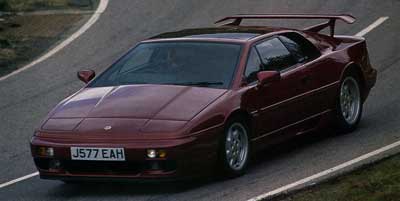
Highland Fling
How does the new, improved Lotus Esprit SE square up to the latest crop of supercars?
Performance Car 'Pull Out' 1992
by Peter Tomalin, photography by John ColleyFive hundred miles is a bloody long way to go to find some oik has started digging up on of your favourite roads. They're taking the corners out of the A9, some of the last decent corners left in the British Isles, and someone has got to act. It is, of course, all a plot by the Scottish Nationalists – give us independence or we'll start straightening out the corners of the A9, one a month till there's none left. The Nats know, of course, that the English don't have any corners – or at least precious few that aren't clogged with clots in Nissan Micras. Give them their independence, says I.
Having travelled all the way from Peterborough to Inverness to relive one of the greatest drives of my life in one of the world's greatest cars, I was fairly smacking my chops at the thought of the first hairpin – the first of a series of three north of Brora.
'Nearly there,' I reassured photographer John Colley, who was beginning to voice his doubts about the whole enterprise, 'Just round this corner,' I burbled on, 'there's the first of three fabulous hair. . .'
And my voice trailed off as we rounded said corner to be confronted by . . . just another corner. A swathe of gently-bending, freshly-laid tarmac (so fresh there weren't even any white lines) where once had been that delicious contortion. They'd even started uprooting the armco – there was no longer any need.
'Oh my gawd,' was all I could manage, as Colley shifted uncomfortably in the seat beside me. There was nothing to do but drive on – and hope the road constructors had all been laid off under British government policy.
Sweet mercy – a few miles further and there it was: the second hairpin. And I knew we had our story.
A story that actually begins almost three years ago, at a time when I was working for another rag and Lotus had just launched its first 'chargecooled' Esprit Turbo SE. Back then, we though it would be a jolly wheeze to take three new cars – Esprit, Peugeot Mi16 and Nova GTE – from Land's End to John O'Groats in a day. The idea was to find out if you needed supercar performance for such a trip. The answer was no, you don't, but everyone agreed that it made the whole daft thing rather more than tolerable if you were at the wheel of a supercar instead of a warmed-over shopping trolley. Hmmm.
Whatever, the wheez became rather jollier the following morning when I was handed the keys to the Esprit for the drive back from John O'Groats to Inverness. And this was truly the stuff of which dreams are made. Back in 1989, the Esprit SE was the fastest accelerating production car in the world. To drive it on any road was a thrill, but to drive the A9 where it hugs the north-east coast of Scotland and dishes up every kind of corner you can imagine and more than a few galloping straights – all with scarcely another car in sight – was a thrill that would blaze itself into the memory cells.
I vowed to return, and come April 1992 when editor Clark wondered aloud what we could do with the latest Esprit SE, Tomalin accelerated from 0 to 2500-word feature concept in about four seconds flat.
But there was more to it than simply a highland fling, for these are difficult times for Lotus, which needs all the good news it can get. A two-day test that would take in 1300 miles on all kinds of roads and in absolutely all weathers – our epic drive north would see sunshine, showers and even the old flurry of snow – would hopefully confirm that the mid-engined Esprit, for so long Britain's one rival to the Italian exotics, still has what it takes.
For 1992, the £47,790 Esprit SE boasts a number of changes, the most obvious of which is that new rear wing. It's been raised like that to lift it out of the turbulent airstream over the rear deck, the better to create downforce and aid stability. Unfortunately it hasn't been able to avoid a stream of criticism from journalists who reckon it detracts from the Esprit's clean good looks. One can't help thinking that Peter Sevens, the man who restyled the Giugiaro original and went on to pen the new Elan before moving to pastures fresh, would have found a solution that wouldn't have jarred so.
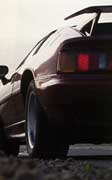
Still, the raising of the wing has one major plus, and that's in rearward visibility. The old SE had about as much as Quasimodo. Now you get a clear view of the Golf GTi behind and the driver's face as you floor the throttle and leave him for dead, pretending he wasn't really trying to keep up, just retuning the stereo actually . . .
While it was about it, Lotus revamped the rear deck to improve the airflow and aid engine cooling, and the new 'flat back' tailgate with its attractive slats is a success, aesthetically and aerodynamically – add in the new rubber lip at the front of the car and the drag co-efficient is down slightly to 0.33, while front axle lift is not said to be almost zero. The effect, says Lotus, is to raise top speed marginally, to 165mph, and reduce understeer at high speed.
Apart from a few minor tweaks to the suspension and a reduced castor angle in the unassisted rack and pinion steering to lighten the exertion needed at lower speeds (both changes introduced on the 1991 car), all other efforts have been targeted at the interior. And very worthwhile they were too.
The first thing you notice is that the door opens wider – by 15 degrees, according to the press blurb. And while a certain looseness of limb is still called for as you duck and dive – ducking the low roofline and diving across the sill – access and egress are both eased.
But the biggest improvements are saved for the moment you get behind the wheel. There's more legroom, there's more armroom, and, if you'll forgive the the expression, there's even more bumroom, for the seats are broader than before. Gently curving buckets, they hold you like the palms of huge leathery hands.
The extra space has been liberated by making the centre tunnel lower and narrower, while the rear bulkhead is slimmer. We're talking an inch here, an inch and a bit there, but it makes a difference, it really does.
Equally welcome are the smart new controls for heating, ventilation and air conditioning, which not longer look like they've been lifted from my two-year-old daughter's toy cooker – who knows, Lotus might one day ditch the door latches (British Leyland, circa 1973). Finally, the 1992 Esprit has a new pedal box to give shorter pedal travel and increased footwell space.
But all of this was by the by as we eased onto the A1 at 9.30pm and left behind a drizzle-laden Peterborough. We had a long, long way to go and our only thought was how painlessly the Esprit might devour the first 500 miles. If it served up some fun on the way, that would be a bonus.
First roundabout, first snag. As my right foot squeezed the brake pedal the revs surged: the right edge of my shoe was catching the throttle. Now, when you're driving nearly 50 grand's worth of someone else's supercar, you don't want to be pressing the wrong pedals. With Colley's consent, I removed my shoes. So the first black mark for the Esprit, new pedal box or not.
That apart, the Esprit was making all the right moves. The ride was quite superb, smothering all but the worst ridges and craters in the average British A-road's repertoire. Equally impressive was the damping of road noise, and with the engine not a remote hum, rising only to a muted growl at higher revs, the loudest sound was the wind rushing round the multifarious seals for doors, tailgate and lift-out root.
After a couple of hours we'd 150 miles under our belts, as a signs for Nottingham, Sheffield and Scotch Corner flashed past. The Esprit was demanding little, occasionally flexing its muscles as we powered out of roundabouts, the massive rear tyres, 245/50 ZR16 Goodyear Eagles, simply converting abundant torque into relentless, drama-free acceleration.
Efficiency. That's what the Esprit Turbo SE is all about. While the Italians indulge in orgies of cubic inches and multiple cylinders, the Esprit gets by with just 2174cc split between four pots. Twin overhead cams and four-valve cylinder heads of course, but the kick comes from the Garrett TB03 turbocharger.
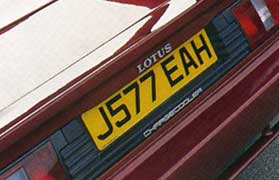
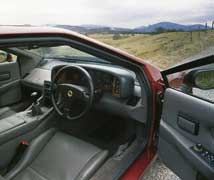
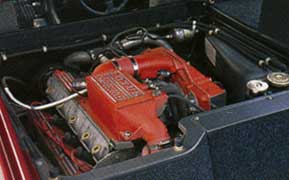
Chargecooling? That's Lotus's way of connecting the turbo compressor directly to the plenum nozzle. With a series of air and liquid passages and internal fins, it maximises heat transfer while minimising pressure loss – more efficient, says Lotus, than a conventional intercooler on a turbo engine.
With electronic multi-point fuel injection and distributorless ignition, a mere 2.2-litre four-cylinder engine churns out 264bhp at 6500rpm and 261lb ft torque at 3900rpm, enough to see it blast from standstill to 60mph in 4.7 seconds and past the quarter-mile post in 12.8. And it's that final figure that gives the true measure of the Lotus's performance – just take a glance though our Performance File and you'll find few cars that even come close.
Darlington, Newcastle and Berwick-upon-Tweed came and went. Five and a half hours after we'd set out, we were skirting Edinburgh. The A1 had been a good companion today – fast and virtually cone-free. One last dash of motorway and we picked up the A9 for Perth; still fresh, still comfortable in those broad, supportive seats. At one point the rear window of a preceding coach was filled in seconds with gawping schoolboys – it's good to know a supercar is still a match for Super Mario Brothers.
As the stretches of dual carriageway became fewer and further between, the Esprit began to earn its keep. And if you're one of those people who steadfastly refuse to see the point of a supercar, you should have been with me over the next two hours. The Esprit doesn't just overtake – that's too tame a term. It annihilates whole convoys of cars, trucks, caravans – anything that stands in its way.
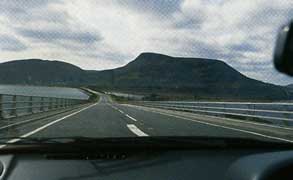
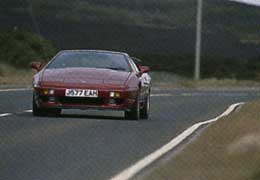
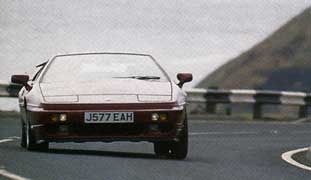
You're doing 50mph, there's half a dozen cars ahead, each clinging to the bumper of the one in front, each driver too dozy even to contemplate passing the juggernaut at the top of the queue.
No problemo.
Select third, and dart out for a quick recce. There's about a quarter-mile slot before the next oncoming car. Full throttle, and the Esprit seems to sniff the air momentarily as the turbo winds up to full boost, then you're off on a dizzying headlong charge. A flick of the wrists and you're back in the left-hand lane, the oncoming car, its driver poised to give an admonishing flash of headlights, still a hundred yards or so away. The Esprit creates gaps where none appeared to exist and negates any apparent risk. Efficiency.
At last, at long last, we were at Inverness. Up till now the A9 has been fast enough – enjoyable, too, as it wound through the majestic Grampians, the loftiest peaks dusted with snow like sugar icing – but from here to Wick it would be challenging as well, placing real demands on car and driver.
Crossing the Firths of Moray, Cromarty and Dornoch, the North Sea looked icily forbidding in the fading evening light. Picking off the last few pockets of traffic, the Esprit was charging hard, exhaust rasping as the revs soared to 6000, turbo wastegate fluttering before the next snatched gear. It's a slightly rubbery shift, heavily sprung to the third-fourth plane so that you sometimes select fourth when you want second, but show it who's boss and it's swift enough.
Skirting Dornoch, the A9 was changing in character, springing the occasional sharp twist among the fast, broad sweepers. Through the tightest turns the Esprit was starting to push its nose wide, but always with plenty of warning through the rim of the wheel. The steering was alive, a stream of information. Just as important, it refused to be corrupted by surface irregularities, tracking faithfully, imparting a sense of unshakeable security.
Hard on the throttle out of 90° turns and I could feel the onset of mild oversteer, but forget about lurid tail-slides – the Esprit's chassis is too darn efficient for that. And it grips so hard you seldom get close to exploring its limits on the public road.
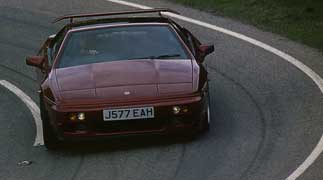
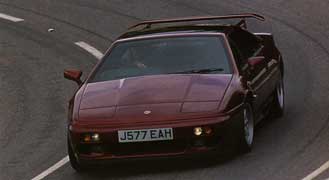
Beneath the glass-fibre bodyshell, with Kevlar reinforcement for the roof section, there's the same galvanised steel backbone carrying upper and lower wishbones to the front, transverse links with trailing radius arms to the rear, coil springs and telescopic dampers all round. It's a wonderful chassis, combining great suppleness with exemplary wheel control.
On through Brora and Helmsdale, and the Esprit was starting to spring together whole series of bends – don't allow the engine to fall too far off boost, measure steering inputs carefully, and you can cover this sort of ground as quickly as your dare. It was all coming flooding back to me now – the car's knockout punch down the straights (the engine management makes up to 280bhp available for short bursts), its utter composure at ridiculous speeds through long, testing bends, glimpses of deserted road on the next hillside several miles ahead, and, just to may side, the sea. . .
We snatched photographs where we could and arrived in Wick at 8.30pm, just as night finally descended. As the Esprit ticked quietly to itself, we eased out and stretched our limbs – but we weren't aching. We weren't even that tired. Considering the vast distance – just over 600 miles – and the long hours on the road, we were feeling remarkably good.
It's a very special car, this Lotus. It has its faults – tall drivers will find some of the instruments partially obscured, the pedals are just too tightly grouped, wind noise can become irksome on the motorway – but show it the right road, a road like the A9, give it its head, and it will dazzle you with its abilities. A well-driven hot hatch might have stayed with it through those hairpins, but they'd have retreated in the rear-view mirror like they were standing still on those sweeping bends, let alone when the Esprit caught the scent of a straight.
If there's one reason why more people aren't beating down Lotus's door to own an Esprit, it probably lies in that super-efficient but, at the end of the day, uncharismatic four-pot engine. Just imagine an Esprit with a V6 engine that sounded as good as the one Honda uses in the NSX. I can. In fact, when you're ready at Hethel, I think I feel another feature idea coming on. . .